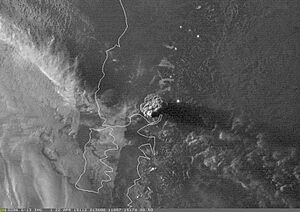Calbuco (volcano) facts for kids
Quick facts for kids Calbuco |
|
|---|---|

Calbuco, prior to its recent eruption, viewed from the north alongside Road 225 on the shores of Llanquihue Lake. (February 11, 2010)
|
|
| Highest point | |
| Elevation | 2,015 m (6,611 ft) |
| Prominence | 1,946 m (6,385 ft) |
| Listing | Ultra |
| Geography | |
| Location | Los Lagos, Chile |
| Parent range | Andes |
| Geology | |
| Age of rock | Pleistocene |
| Mountain type | Stratovolcano |
| Last eruption | April 2015 |
Calbuco (pronounced kahl-BOO-koh) is a large, cone-shaped volcano in southern Chile. It is located near Llanquihue Lake and Chapo Lake, in the Los Lagos Region. The cities of Puerto Varas and Puerto Montt are also close by.
Calbuco stands 2,015 meters (about 6,611 feet) tall. The volcano and the land around it are part of the Llanquihue National Reserve. This means the area is protected.
Calbuco's most recent eruption was a big one. It happened suddenly on April 22–23, 2015. A smaller eruption followed on April 30, 2015. Before this, Calbuco had not erupted since 1972.
Contents
Where is Calbuco Located?
Calbuco volcano is partly in the Puerto Varas area and partly in the Puerto Montt area. It is about 49 kilometers (30 miles) from Puerto Varas. It is also about 69 kilometers (43 miles) from Puerto Montt.
Its name likely comes from the Mapuche language. "Kallfü" means "blue" and "ko" means "water." So, Calbuco might mean "blue water." The volcano shares its name with Calbuco Island and the city of Calbuco. However, the volcano is not located in the city of Calbuco.
What Kind of Volcano is Calbuco?
Calbuco is a very explosive type of volcano called an andesite volcano. Its lava usually contains a lot of a substance called silicon dioxide. This makes the lava thick and sticky.
The top of the volcano has a wide crater, which is about 400 to 500 meters (1,300 to 1,600 feet) across. Long ago, part of the volcano collapsed. This caused a huge landslide that reached Llanquihue Lake.
Calbuco's Eruptions
Calbuco has erupted many times throughout history. Scientists have confirmed 36 eruptions since the last Ice Age ended. Thirteen of these eruptions have been recorded by people.
In the 1900s, Calbuco erupted several times. These eruptions happened in 1906, 1907, 1909, 1911, 1917, 1929, 1932, 1945, 1961, and 1972.
The 2015 eruptions were a series of three events. They took place from April 22 to April 30, 2015.
Past Major Eruptions
The eruption of 1893–95 was one of the biggest in southern Chile. It threw out rocks and ash up to eight kilometers (5 miles) away. Hot mudflows, called lahars, also came down the volcano.
This eruption greatly affected the German settlers living near eastern Llanquihue Lake. Their potato fields, cattle, and beekeeping were all harmed. Many settlers had to move their cattle away. They also asked the government to help them move to a new area.
In April 1917, there were strong explosions. A dome of lava formed inside the crater. Hot mudflows also occurred. Another short, explosive eruption happened in January 1929. This eruption included fast-moving flows of hot gas and ash, and a lava flow.
The big eruption of 1961 sent ash columns very high into the sky, about 12–15 kilometers (7–9 miles) high. The ash clouds mostly spread to the southeast. Two lava flows also came out of the volcano.
A smaller eruption happened on August 26, 1972, and lasted for four hours. On August 12, 1996, scientists saw a lot of steam and gas coming from the main crater.
The 2015 Eruption
The most recent eruption was in April 2015. On April 22, the volcano erupted suddenly with little warning. It sent a huge column of ash high into the air. Another eruption happened early on April 23. A smaller eruption then occurred on April 30.
These eruptions were rated as a 4 on the Volcanic Explosivity Index. This index measures how powerful volcanic eruptions are. The volcano's alert level was lowered to the safest level on August 18, 2015.
The ash from the 2015 eruption spread nutrients into the sea. Some scientists believe this might have helped cause a large growth of algae in 2016.
See also
 In Spanish: Volcán Calbuco para niños
In Spanish: Volcán Calbuco para niños
- List of volcanoes in Chile
- List of Ultras of South America
Images for kids
-
Calbuco viewed from the north alongside Road 225 on the shores of Llanquihue Lake (February 11, 2010).
-
From Osorno volcano (July 28, 2006).
-
View of the eruption column of Calbuco Volcano from Puerto Varas, Chile, on April 22, 2015.







